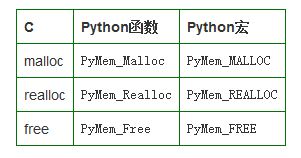时间:2021-07-01 10:21:17 帮助过:34人阅读
0. C语言库函数提供的接口
1. PyMem_*家族,是对 C中的 malloc、realloc和free 简单的封装,提供底层的控制接口。
2. PyObject_* 家族,高级的内存控制接口。
3. 对象类型相关的管理接口
PyMem_*
PyMem_家族:低级的内存分配接口(low-level memory allocation interfaces)
Python 对C中的 malloc、realloc和free 提供了简单的封装:

为什么要这么多次一举:
源码:
Include/pymem.h
#define PyMem_MALLOC(n) ((size_t)(n) > (size_t)PY_SSIZE_T_MAX ? NULL \
: malloc((n) ? (n) : 1))
#define PyMem_REALLOC(p, n) ((size_t)(n) > (size_t)PY_SSIZE_T_MAX ? NULL \
: realloc((p), (n) ? (n) : 1))
#define PyMem_FREE free
Objects/object.c
/* Python's malloc wrappers (see pymem.h) */
void *
PyMem_Malloc(size_t nbytes)
{
return PyMem_MALLOC(nbytes);
}
...
PyMem_New 和 PyMem_NEW
PyMem_Resize和 PyMem_RESIZE
它们可以感知类型的大小
#define PyMem_New(type, n) \
( ((size_t)(n) > PY_SSIZE_T_MAX / sizeof(type)) ? NULL : \
( (type *) PyMem_Malloc((n) * sizeof(type)) ) )
#define PyMem_Resize(p, type, n) \
( (p) = ((size_t)(n) > PY_SSIZE_T_MAX / sizeof(type)) ? NULL : \
(type *) PyMem_Realloc((p), (n) * sizeof(type)) )
#define PyMem_Del PyMem_Free
#define PyMem_DEL PyMem_FREE
PyObject_*家族,是高级的内存控制接口(high-level object memory interfaces)。
注意
源码
Include/objimpl.h
#define PyObject_New(type, typeobj) \
( (type *) _PyObject_New(typeobj) )
#define PyObject_NewVar(type, typeobj, n) \
( (type *) _PyObject_NewVar((typeobj), (n)) )
Objects/object.c
PyObject *
_PyObject_New(PyTypeObject *tp)
{
PyObject *op;
op = (PyObject *) PyObject_MALLOC(_PyObject_SIZE(tp));
if (op == NULL)
return PyErr_NoMemory();
return PyObject_INIT(op, tp);
}
PyVarObject *
_PyObject_NewVar(PyTypeObject *tp, Py_ssize_t nitems)
{
PyVarObject *op;
const size_t size = _PyObject_VAR_SIZE(tp, nitems);
op = (PyVarObject *) PyObject_MALLOC(size);
if (op == NULL)
return (PyVarObject *)PyErr_NoMemory();
return PyObject_INIT_VAR(op, tp, nitems);
}
它们执行两项操作:
初始化没什么好看到,但是这个MALLOC就有点复杂无比了...
PyObject_{Malloc、Free}
这个和PyMem_*中的3个可是大不一样了,复杂的厉害!
void * PyObject_Malloc(size_t nbytes) void * PyObject_Realloc(void *p, size_t nbytes) void PyObject_Free(void *p)
Python程序运行时频繁地需要创建和销毁小对象,为了避免大量的malloc和free操作,Python使用了内存池的技术。
单次申请内存块
当申请大小在 1~256 字节之间的内存时,使用内存池(申请0或257字节以上时,将退而使用我们前面提到的PyMem_Malloc)。
每次申请时,实际分配的空间将按照某个字节数对齐,下表中为8字节(比如PyObject_Malloc(20)字节将分配24字节)。
这些参数由一些宏进行控制:
#define ALIGNMENT 8 /* must be 2^N */ /* Return the number of bytes in size class I, as a uint. */ #define INDEX2SIZE(I) (((uint)(I) + 1) << ALIGNMENT_SHIFT) #define SMALL_REQUEST_THRESHOLD 256
pool
每次申请的内存块都是需要在 pool 中进行分配,一个pool的大小是 4k。由下列宏进行控制:
#define SYSTEM_PAGE_SIZE (4 * 1024)
#define POOL_SIZE SYSTEM_PAGE_SIZE /* must be 2^N */
每个pool的头部的定义如下:
struct pool_header {
union { block *_padding;
uint count; } ref; /* number of allocated blocks */
block *freeblock; /* pool's free list head */
struct pool_header *nextpool; /* next pool of this size class */
struct pool_header *prevpool; /* previous pool "" */
uint arenaindex; /* index into arenas of base adr */
uint szidx; /* block size class index */
uint nextoffset; /* bytes to virgin block */
uint maxnextoffset; /* largest valid nextoffset */
};
注意,其中有个成员 szidx,对应前面列表中最后一列的 Size class idx。这也说明一个问题:每个 pool 只能分配固定大小的内存块(比如,只分配16字节的块,或者只分配24字节的块...)。
要能分配前面列表中各种大小的内存块,必须有多个 pool。同一大小的pool分配完毕,也需要新的pool。多个pool依次构成一个链表
arena
多个pool对象使用被称为 arena 的东西进行管理。
struct arena_object {
uptr address;
block* pool_address;
uint nfreepools;
uint ntotalpools;
struct pool_header* freepools;
struct arena_object* nextarena;
struct arena_object* prevarena;
};
arean控制的内存的大小由下列宏控制:
#define ARENA_SIZE (256 << 10) /* 256KB */
一系列的 arena 构成一个链表。
引用计数与垃圾收集
Python中多数对象的生命周期是通过引用计数来控制的,从而实现了内存的动态管理。
但是引用计数有一个致命的问题:循环引用!
为了打破循环引用,Python引入了垃圾收集技术。